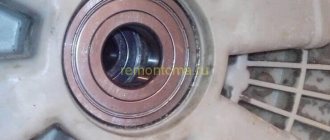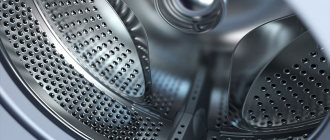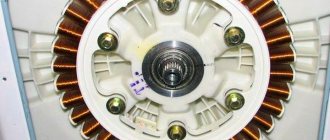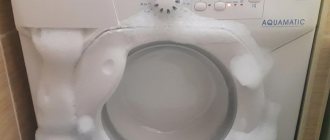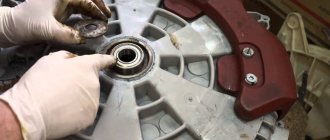Regular washing leads to the appearance of excess moisture in the drum, mold, bacteria and fungi appear, as a result, the quality of the wash deteriorates and parts break prematurely. Standard rinsing does not completely eliminate breeding spots, so it is necessary to clean the washing machine, especially if there is no self-cleaning function.
Washing hygiene
Automatic washing machines are designed to save the owner from unnecessary hassle. But are they really independent? You load clothes into the drum, add powder, press a button and after a while you get clean clothes. Particles of dirt, lint, threads and pet hair remain in the drum.
Only part of this small debris enters the filtration system and is discharged into the sewer. Tiny fractions settle on the walls, where they become an ideal environment for the proliferation of pathogenic fungi and bacteria.
You load new clothes, and all this microflora ends up on things, because the standard washing mode involves heating the water only in the range of 30-60°C. This temperature is not enough to kill pathogens.
Features of the work of SMA "Indesit"
When using Indesit washing machines, follow these rules:
- Please note the maximum permissible drum load.
- Sort your laundry by color, type of fabric, color fastness and presence of decor (embroidery, beads, rhinestones, etc.). The presence of decorative decorations is a reason to use special bags.
- Read the labels on things - what is allowed and what is prohibited for a particular product.
- Check your pockets - this will prevent damage to the SMA.
- Turn sweaters, shirts and other clothes inside out - this will improve the quality of washing.
- It is forbidden to wash many large items at the same time so as not to disturb the balance of the drum.
- When pressing the “start” button, make sure that the device is turned on.
- When choosing a mode, turn the selector to the desired position. If necessary, adjust the process parameters using special switches. After adjusting the software settings, start the device.
Self-cleaning washing machine
The eco drum cleaning function does not require the addition of any cleaning agents or disinfectants; the machine cleans everything on its own. The cleaning cycle is carried out at a temperature of 70 degrees for 90 minutes.
This allows you to disinfect the inside of the device, remove scale, mold and unpleasant odors - it is impossible to change these parameters, they are set automatically by the electronics of the washing machine.
The eco-drum cleaning program makes it possible not only to maintain hygiene inside the device, but also significantly extends the performance of the unit. In addition, by regularly cleaning the washing machine, you will save energy, because the electric heater is also cleaned of plaque adhering to it, and, therefore, heats the water much faster and more efficiently.
Folk remedies
We will share with you folk methods of cleaning a washing machine, which are aimed at combating scale. Its harm to the washing machine is obvious:
- Increased electricity consumption. Scale gradually covers the heating element and the element requires more and more energy to heat up.
- The direct cause of machine breakdown is that the heating element, covered with scale, is working, as they say, “on its last legs.” By the way, if such a “tormented” heating element is not replaced in time, the problem can lead to a more expensive breakdown of the device’s software module.
- Scale is an excellent environment for mold to form.
Neglected case
How does the drum clean function work?
Cleaning looks like a regular wash without laundry and consists of several stages:
- The pre-wash mode is activated.
- The main mode or cleaning starts at 60 degrees with speeds up to 150 rpm.
- The program ends with a double rinse and a spin at the highest possible speed.
To prevent the formation of plaque and clogging, it is enough to carry out preventive cleaning of the drum twice a month. We strongly recommend that you clear the drain filter of debris before starting this function.
Important! Using this cycle does not remove or prevent scale.
Adviсe
Before starting the automatic cleaning mode, it is a good idea to inspect for blockages and, if necessary, clean the drain hose and filter.
Complete cleaning of the drum requires additional cleaning of the elements in contact with it. So, with the drum, the rubber seal of the hatch is cleaned of dirt and soap deposits .
Wipe the cuff on all sides with a soft sponge. A toothbrush will help clean hard-to-reach places.
Alternating cleaning with professional and folk remedies will help you achieve the best results - a perfectly clean drum and adjacent elements of the washing machine.
Scope of application of the cleaning function
The drum, where stale laundry is placed and where detergents get in, is more susceptible to contamination than other parts of the washing machine.
It also comes into contact with hard, poorly filtered water containing harmful impurities:
- Iron,
- Technical, edible oils,
- rust,
- Chlorine,
- Calcium and magnesium salts.
With frequent use of the machine, especially in large families, the drum constantly remains wet, with puddles and smudges. An environment favorable for the development of microorganisms and bacteria that pose a threat to health is formed. The situation is aggravated by the habit of some housewives of storing dirty clothes directly in the washing machine.
Cleaning the inlet hose filter
You are almost certainly faced with a clogged problem if your washing machine is slow to fill. The filter of the device captures debris from the water supply, prevents it from entering the machine and protects the internal parts. It is possible that it is clogged with mineral deposits and tiny particles of debris.
Contamination occurs most often after repairs to the water supply system (both in an apartment and in a public network). Any work on water supply lines increases sediment in the pipes, and, as a result, on the filters. And it’s worse if the hose is clogged. This component of the washing machine is more difficult to clean.
Cleaning the filter is not difficult. The only thing you need to be careful when you remove the filter. Don't yank it. Gently squeeze and twist as you pull towards yourself. If it bends a little, return it to its original shape by straightening it with your fingers.
Tip: If there are too many lime deposits on the filter, it is unlikely that you will be able to wash it. Buy a new one: they are inexpensive and sold at plumbing stores.
What you need to prepare before cleaning the filter:
- screwdriver 4 in 1;
- needle nose pliers;
- utilitarian knife.
The procedure is as follows:
1. Turn off the water, disconnect the hoses.
2. Use a pair of pliers to remove the filter. 3. Remove sand and debris from it. Pry out the stuck particles with a knife. 4. Rinse under water or blow with a hairdryer. 5. Put the filter in place by pressing on the rim with a screwdriver. 6. With hoses and water, do everything in reverse order: connect the hoses, turn on the water, checking for leaks.
Why do you need to clean the washing machine drum?
The drum, when dealing with dirty laundry, becomes dirty over time. In washing machines without automatic cleaning, you have to do it yourself. To do this, pour bleach, vinegar, citric acid into the machine, add soda or other cleaning and disinfectants.
Thanks to treatment with cleaning agents, the drum gets rid of dirt, bacteria, mold, scale, unpleasant odors and soap deposits. If you don’t clean the “inside” of the machine in time, a putrid smell will emanate from it, and washed items will also smell like it.
If you neglect the cleanliness of the SMA, it will fail prematurely. If you bought a model with Eco, you don’t have to use special cleaning products or run the washing machine empty - the device will take care of its cleanliness.
More: Description and characteristics of Bosch Maxx 5 Speed Edition
Ambulance
There are many products available on store shelves to combat drum contamination. By choosing ready-made products, you will spend less time and effort fixing the problem. There is also an alternative method, more economical, but just as effective. For help you should turn to folk recipes.
The most popular substances used at home:
- Citric acid copes well with stains and is included in most cleaning products offered in stores.
- Acetic acid is similar in principle to citric acid.
- Baking soda - used in conjunction with other ingredients.
- Bleach is ideal for eliminating unpleasant odors.
- Copper sulfate - used for disinfection treatment, eliminates mold and mildew.
If your washing machine does not have a self-cleaning drum mode
It is necessary to familiarize yourself with the list of detergents recommended by the manufacturer for cleaning the drum, specified in the operating instructions for your washing machine. As a last resort, you can use “folk remedies”. But, of course, it is worth remembering that they can be used rarely and with extreme caution.
How to clean a washing machine drum with citric acid
Pour 100-200 g of citric acid (depending on the load of your model) into the powder compartment and turn on the wash at high temperature and high speed.
How to clean a washing machine drum with vinegar
Pour 250 ml of 9% vinegar into the powder compartment. Activate the high temperature wash function. After the mixture of water and vinegar has warmed up, pause the wash for 60 minutes, then resume the process and complete it. After finishing the process, keep the hatch open and let the vinegar smell disappear from the machine.
How to clean a washing machine drum with soda
Mix 200 g of soda and 200 g of water (in a one to one ratio). Apply the resulting slurry to the drum of the machine, the glass of the hatch cover from the inside, and also to the rubber cuff of the hatch. Leave the mixture in the machine for half an hour and then remove with a damp sponge. Then start the rinse mode in the machine.
How to clean a washing machine drum with chlorine
Pour 250 ml of 0.5% chlorine solution into the powder compartment. Turn on the wash at the highest temperature and high speed.
If you have any doubts that during cleaning the drum, the product you used remains on the internal parts of the washing machine, then you should start the washing mode again (after maintaining the time interval specified in the instructions for your LG washing machine). Otherwise, it may lead to damage to the laundry in the future.
How to clean a washing machine drum with powder
Applicable to:
- Front-loading washing machine (integrated or freestanding),
- Top loading washing machine.
Solution:
- Remove all laundry from the drum
- Select the Cotton program and set the temperature to the highest possible
- Add a small amount of powder detergent to the empty drum to remove any remaining dirt.
From time to time, at the end of the cycle, the icon may appear on the display.
– it notifies that it is recommended to clean the drum.
When the drum is cleaned, the icon disappears.
How to clean the powder compartment?
Cleaning the washing machine must be carried out comprehensively. In this case, it is necessary to pay attention not only to the heating element, but also to the powder compartment. Deposits also form on its surface and in the niche where it is inserted.
This leads to:
- hard water;
- remnants of detergent that are not completely washed;
- air conditioner residues;
- dust and other pollutants.
Incompletely rinsed residues of powder, gel and conditioner can be easily removed in warm water using a small brush.
Work order:
- Pull the container out of the hole.
- Remove the removable part in the air conditioner compartment from the cuvette.
Rinse in water.- Using baking soda and a brush, scrub the container on all sides.
- In case of significant lime deposits, it is possible to use bleach for cleaning.
- Pour hot water into a bowl of suitable size, into which the removable container fits entirely, and dilute the packet of citric acid.
- Place the cuvette in the bowl and leave for at least 1 hour. Maybe longer. If there are significant scale deposits, the cuvette can be left soaked in citric acid for several hours.
- Clean with a brush, paying attention to all joints.
- Wipe the cuvette.
- Install the removable part for the air conditioning compartment.
- Place the cuvette in place in the grooves.
It is convenient to use an old toothbrush with a small working head to clean the container.
The video will show you how to clean the powder tray from scale and mold:
Preventing drum contamination
Dampness and warm temperature in the washing machine after washing are a favorable environment for the appearance of fungus and mold. Debris, dirt and unwashed detergents, settling on the rubber door seal, drain hose, filter and powder tray, cause germs to multiply.
Also, washing items heavily soiled with greasy substances leads to the settling of undissolved sediments on the drum, tank and rubber cuffs.
The source of drum contamination is often limescale. Due to the presence of salts and impurities in running water, an insoluble precipitate forms when heated. As a result, the heating elements are covered with a layer of scale, which increases over time, preventing thermal conductivity. This affects the quality of water heating and energy consumption.
To prevent dirt and scale, you must:
- Wash at high temperature at least once a week, but up to 75 degrees, since scale formation begins at this value;
- wash out any remaining detergent from the tray;
- wipe the hatch seal dry;
- 1-2 times every 2-3 months (depending on the operation of the machine), carry out preventive cleaning with citric acid or vinegar;
- ventilate the tank after washing, leaving the hatch ajar for an hour to an hour and a half.
Taking into account the feedback from washing machine repair specialists, models with a drum cleaning function are kept in a neater condition and are less prone to breakdowns. This is explained by the fact that users are more willing and often to clean the machine of accumulated dirt with this program, since it does not require cleaning agents or physical effort.
What does Indesit offer?
Mode is a process characterized by certain conditions. The temperature, drum rotation speed, time and goal vary. A program is a specific procedure, which, differing in washing conditions, can consist of several modes.
Basic
- Cotton. T-shirt or cotton box drawn. The user can select options with different temperatures and durations:
- 90–95 degrees is a good option if you need to wash stained kitchen towels. The drum is fully loaded. And the cycle time is almost 3 hours.
- 60 degrees. With intensive washing, the process is shorter, since the soaking step is eliminated. Duration is reduced to 2.5 hours. This option is chosen for heavily soiled white items - tablecloths, towels, bed linen.
- 40 degrees. Recommended for colored products. Duration - about 2.5 hours.
- Synthetics. A flask with temperature indication is shown. There are two options:
- 60 °C - 1 hour 25 minutes.
- 40 °C - gentle version, lasting 1 hour 11 minutes. Loading - 50%. This is usually 2.5–3.5 kg, depending on the model.
- Wool. A skein of thread is drawn. For wool and cashmere items. Duration - 55 minutes. Temperature: 40°C. Spin speed is reduced.
- Silk. The picture shows a T-shirt. For curtains made of thin fabrics, for viscose and underwear. They are washed at 30°C for 55 minutes. Load the drum by about 20% - up to 1–1.5 kg. There is no spin.
Some models may contain separate modes, without an emphasis on fabric. Washing available:
- Preliminary. Use instead of soaking. Gently rotate in slightly warm (30 °C) water.
- Daily (everyday) is a standard program for quickly washing lightly soiled items.
- Intense. For cotton and linen. Hot water - up to 95 °C. This is an analogue of “cotton 90 °C”.
- Delicate - similar to “wool”. You can wash completely different fabrics that have one thing in common - special requirements for process conditions. Wool, organza, lycra and other delicate materials are washed at 40 degrees.
Additional
They are chosen for specific items, taking into account the fabric and degree of contamination:
- Washing modes and times in the Atlant washing machine
- Jeans. The icon matches the name. Created specifically for denim products. Wash at 40 degrees. Loading - up to 2.5 kg. Drum speed is reduced.
- Quick wash mode. The picture is a clock. The express version allows you to wash things in a quarter of an hour. Loading - about one and a half kg. Temperature: 30°C.
- Shoes. The picture shows a sneaker. Designed for sports shoes - sneakers, suede sneakers. Wash in lukewarm water, two pairs at a time. Cycle duration: 50 minutes.
- Sportswear. There are models with two options - regular and intensive. The water is heated to 30 °C. Time - 1 hour 20 minutes.
SMA "Indesit" also has special functions:
- additional rinse - intuitive designation - variations on the theme of drops and a basin of water;
- spin - a pattern in the form of a twisted spiral;
- Eco Time - reduces time and water consumption. Compatible with synthetics and cotton 40.
- easy ironing - iron drawn;
- delayed start - icon with a clock.
Self-cleaning washing machines
Most modern models of washing machines from the brands LG, Samsung, Haier, Hotpoint, Electrolux, Gorenje, Haier, Ariston, Beko, Indesit and many others are equipped with a self-cleaning function.
For example, the BEKO WMI71241 model - with its classic design and maximum load of up to 7 kilograms of laundry, is equipped with a self-cleaning program - that is, washing with an empty drum at high temperature without detergents.
The LG F-1296ND3 model, a very popular built-in model designed to load 6 kg of laundry, also has this capability.
Manufacturers of the LG brand have made a special series “Direct Drive” - the models of which have at least 10 programs (depending on how much the car costs, their number varies), among which there is self-cleaning.
What buttons and selectors are there?
Any Indesit SMA has the following elements on the control panel:
- Program switch. There are icons on the panel, duplicated with pictures. The consumer turns the selector to select the desired option.
- Temperature switch. If the user selects a specific program, the temperature is set automatically. But thanks to the selector, you can adjust the water heating.
- Speed switch. The rotation speed of the drum can also be changed - in any direction.
- Start/stop or on/off button. Activates and deactivates the machine. Near the button there is an LED indicating the state of the device.
Also on Indesit machines, depending on the model, there are additional buttons:
- 50% load. It is pressed if you need to wash several items. Saving water and electricity.
- Reducing the spin speed. Use for delicate fabrics.
- Super rinse. For thorough rinsing.
- Cold wash. For delicate materials and not very dirty things.
- Disabling spin.



